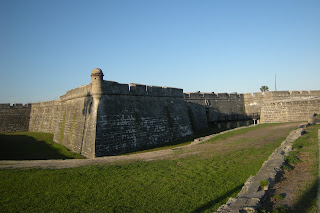We made it over to the east coast to St. Augustine today. When we had gone through this area last month if was cold and rainy with the clouds clear down to the road. The weather was perfect today. You could spend a couple of days here and still not see everything. We stuck to the Colonial Spanish Quarter, the Castillo de San Marcos or fort, and Henry Flagler’s Hotels. Construction of the fortress was begun in 1672 but most of what we see today goes back to 1756. Its walls are made out of a limestone that is called Coquina and are a couple of feet thick. It has survived sieges, bombardments and hurricanes and has flown 6 different flags beginning with the Spanish. St. Augustine was established in 1565 by the Spanish and the settlement is the oldest permanent settlement in the continental US. Thus they claim the to have the oldest of many things including the oldest house and the oldest school. The Colonial Spanish Quarter is now a very touristy pedestrian friendly area with trams telling tourists about the area, homes as museums, and lots of restaurant and shops. It is very charming and inviting. We enjoyed an ice cream cone as we walked along the streets.
 |
| Castillo de San Marcos |
 |
| Guard at Entrance |
 |
| Really Interesting Cannons |
 |
| Chris at the Entrance of the Colonial Spanish Quarter |
We had read, good old AAA tour books, that the Lightner Museum had a demonstration of 19th century mechanical musical instruments at 2:00 and made sure to be there. The museum along with the City Hall is in Henry Flagler’s Alcazar Hotel. This was the second hotel he built and is a magnificent building. It was known for its spa. It boasted Russian baths, an indoor pool and an exercise area. The ballroom was on the second floor and overlooked the pool. The demonstration of the mechanical instruments was fascinating! Our guide played a number of machines, none that I had seen before, dating back to the late 1800’s to the 1920 or 30’s. The later ones were similar to our jute boxes taking a nickel or dime to play a song using paper reels. They were putting small bands out of work thus forming the musicians union. It was amazing to hear them played. You can go on YouTube doing a search on “Lightner Music Machine” to see and hear some of the amazing music. One that played both a player piano and violin was called the Violano Virtuoso. Another older machine was a player piano with drums, symbols and organ pipes all in one.
 |
| Violano Virtuoso |
 |
| Our Guide is pointing to the player piano.The drums are on the left, the cymbols on the right and the organ pipes are in the middle. |
Across the street is the first Flagler hotel, the former Ponce de Leon, and now the home of Flagler College. We caught the tail end of a tour given by a student. The 1887 building is magnificent both inside and out. Tiffany designed the interior and we saw the entry hall along with the dining hall that includes 79 tiffany windows. Now this beautiful dining room is the dining hall for the students! How wonderful that these two amazing buildings are is such beautiful condition, are still being used, and open to the public. We heard more interesting stories about Flagler. It’s fun to put together the information we have heard about him on various tours. We want to find a good biography on him when we get home. It would make for fascinating reading.
 |
| Detail on the ceiling and dome in the ntry hall of Flagler's Ponce de Leon Hotel built in 1888. |
 |
| Norm and I tried the beer sampler at the Brewery |
 |
| Our Dinner View |
No comments:
Post a Comment